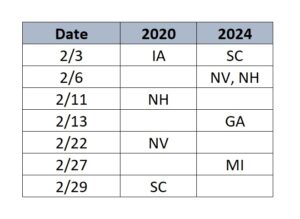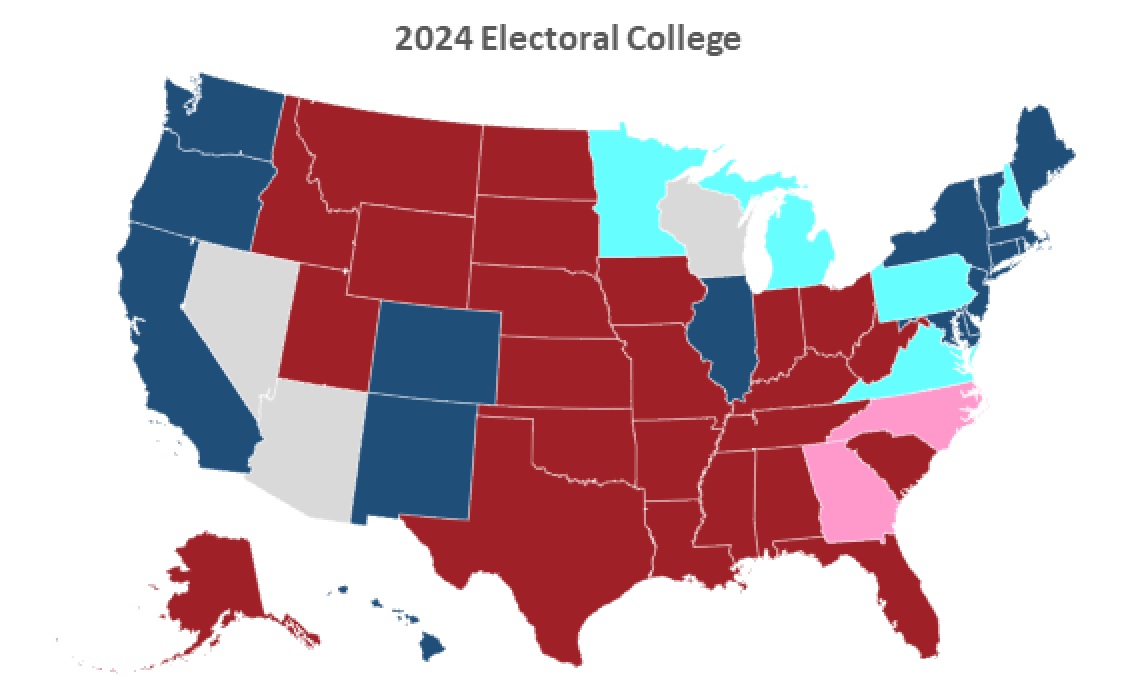The Rules and Bylaws Committee of the Democratic National Committee recently approved President Biden’s proposed changes to the 2024 primary calendar. Their intention was to favor the Democratic party’s current demographics, rearranging state primaries so that the party faithful have more of a voice in selecting a candidate. Here’s a comparison of the first month of primaries in 2020 vs. the 2024 proposal: The 2024 proposal:
The 2024 proposal:
- Increases the February states from four to five.
- Elevates South Carolina to hold the first-in-the-nation primary.
- Demotes New Hampshire out of its traditional first-in-the-nation spot.
- Elevates Georgia and Michigan into February.
- Demotes the Iowa caucuses entirely out of February.
While the new calendar would be very Biden-friendly, it could actually be meaningless if Biden ends up running unopposed in 2024. Furthermore, even if the broader DNC formally approves the changes (which seems likely), it’s unclear whether all of the changes will actually happen:
- Some states (e.g. Iowa & New Hampshire) that would lose their historic influence might well decide to jump the line, in spite of the DNC’s calendar. While the DNC could certainly penalize those states – with the nuclear option being to not count those states’ votes at the nominating convention – that internal conflict wouldn’t play well on national TV.
- Some states (e.g. Georgia) might not be willing to hold the two primary elections on different dates – since the Republican Party isn’t yet planning any changes to their primary calendar.
So would the change be a good idea? And why should you care?
The proposed calendar would likely increase the influence of younger, more racially diverse, and more moderate Democratic voters. That’s a good thing. I also argued back in early 2019 that Iowa was an abysmal choice to lead the parade and, since it’s no longer even a swing state, its exclusion is a good thing The remaining states that had early dates in 2020 would still have early dates in 2024.
Thus, the new calendar is an improvement. It just doesn’t go far enough.
For years, I’ve made no secret of my utter disdain for the Electoral College. However, it is the game we’re playing. With the rules of that game in the current political environment, I count only ten states where Presidential votes will matter AT ALL in the 2024 Presidential election. I’ll revisit this at a later date, but for now, here’s my interpretation of the current 2024 Electoral landscape:
The dark red and dark blue states are in the bag for whoever the two parties nominate in 2024 . (And, yes, I’m aware that I’m ignoring the split Electoral votes in NE and ME – which is fine for my current purposes.)
While some candidates would certainly make a much better showing than others in many of these states, a majority of voters in these states will vote for their party’s 2024 candidate regardless of who it is. Given our winner-take-all approach to state primaries, even a thin majority gives a candidate ALL of each state’s Electoral votes.
As such, these states simply aren’t variables and there is no reason for either party to care which primary candidates their voters prefer. I don’t like it, but that’s the way it is.
That leaves the other ten states as possible swing states. Depending on who the final candidates are, two states that lean Republican “could” vote for the Democrat and five states that lean Democratic “could” vote for the Republican. Only three states are true toss-ups.
Democrats should indeed change their primary calendar, but they should change it to optimize for a general election win. Nothing else matters. Since winning these ten swing states is the goal of the game, the primary calendar should exclusively prioritize these states so that they have the most say in selecting the Democratic candidate.
Four of the five states in the proposed Democratic calendar are potential swing states, with the outlier being South Carolina. While I understand the related desire to increase the influence of black voters in the nominating process, there were better choices. South Carolina has the fifth highest percentage of black voters in the U.S. but that state is not going to cast its Electoral votes for the Democratic candidate whoever it is. Georgia has the third highest percentage of black voters and Virginia has the ninth highest. Both are potential swing states and either would be a better choice to satisfy that need.
Personally, I’d compress the 2024 calendar to hold Democratic primaries for all ten swing states within the six weeks between February 3 and March 16. The proposed early primaries for Nevada, New Hampshire, Georgia, and Michigan are great, but Arizona, Wisconsin, Minnesota, Pennsylvania, Virginia, and North Carolina should also hold early primaries. The order would be less important in a compressed calendar since it would decrease the media attention given to the early winners. However, I would group the primaries geographically to lessen the travel expenses for candidates campaigning in multiple states at once.
All that said, if further tweaks are too big of an ask, the proposed calendar changes are at least a minor improvement.
